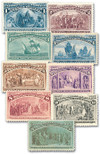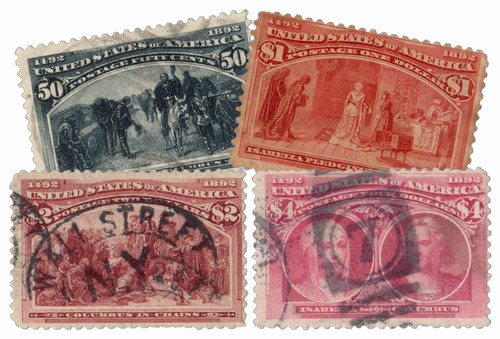
# 230-38 - 1893 U.S. Columbians, 9 Stamps
Get 9 Columbians Today and SAVE
The 1893 Columbian stamps are among the most sought after by collectors around the world. In fact, the degree of completion of the Columbian Series is often the yardstick by which a US collection is measured. And it's no wonder – these are America's first commemorative stamps. (Low issue quantities add to desirability!)
These stamps were issued in advance of Chicago's 1893 World Columbian Exposition. It was an international fair celebrating the 400th anniversary of Christopher Columbus's 1492 arrival in the New World. The series was used to advertise the event – the first time postage stamps were used to promote a commercial event.
The 1893 Columbian Exposition stamp series was like nothing before it. They created a worldwide phenomenon. Expertly engraved and generous in size, the Columbians are among the most desirable of all US stamps.
Now's your chance to own nine Columbians in your choice of used or unused condition with one or two small imperfections. These tiny flaws don't detract from the stamps' beauty or collectibility, but do allow you to get them at a significant savings. Order now and add US #230, 231, 232, 233, 234, 235, 236, 237, and 238 to your collection. You'll be glad you got them while they're still available and affordable.
For items over $200: convenient, interest-free time payments are available to make owning easier. Simply call 1-866-660-7147 and talk to one of our friendly customer service representatives. They'll be happy to help – and you'll be able to break up your payment between your choice of 2 to 5 payments.
Get 9 Columbians Today and SAVE
The 1893 Columbian stamps are among the most sought after by collectors around the world. In fact, the degree of completion of the Columbian Series is often the yardstick by which a US collection is measured. And it's no wonder – these are America's first commemorative stamps. (Low issue quantities add to desirability!)
These stamps were issued in advance of Chicago's 1893 World Columbian Exposition. It was an international fair celebrating the 400th anniversary of Christopher Columbus's 1492 arrival in the New World. The series was used to advertise the event – the first time postage stamps were used to promote a commercial event.
The 1893 Columbian Exposition stamp series was like nothing before it. They created a worldwide phenomenon. Expertly engraved and generous in size, the Columbians are among the most desirable of all US stamps.
Now's your chance to own nine Columbians in your choice of used or unused condition with one or two small imperfections. These tiny flaws don't detract from the stamps' beauty or collectibility, but do allow you to get them at a significant savings. Order now and add US #230, 231, 232, 233, 234, 235, 236, 237, and 238 to your collection. You'll be glad you got them while they're still available and affordable.
For items over $200: convenient, interest-free time payments are available to make owning easier. Simply call 1-866-660-7147 and talk to one of our friendly customer service representatives. They'll be happy to help – and you'll be able to break up your payment between your choice of 2 to 5 payments.














